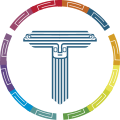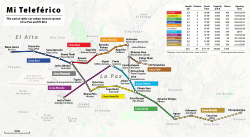
La Paz, officially Nuestra Señora de La Paz , is the seat of government of the Plurinational State of Bolivia. With 755,732 residents as of 2024, La Paz is the third-most populous city in Bolivia. Its metropolitan area, which is formed by La Paz, El Alto, Achocalla, Viacha, and Mecapaca makes up the second most populous urban area in Bolivia, with a population of 2.2 million, after Santa Cruz de la Sierra with a population of 2.3 million. It is also the capital of the La Paz Department.
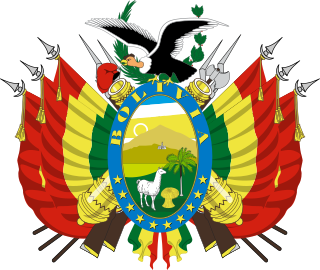
The politics of Bolivia takes place in a framework of a presidential representative democratic republic, whereby the president is head of state, head of government and head of a diverse multi-party system. Executive power is exercised by the government. Legislative power is vested in both the government and the two chambers of parliament. Both the Judiciary and the electoral branch are independent of the executive and the legislature. After the 2014 Bolivian general election, 53.1% of the seats in national parliament were held by women, a higher proportion of women than that of the population.
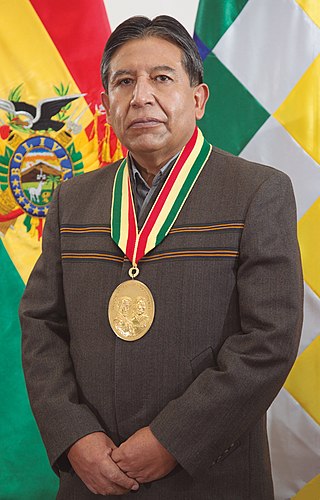
David Choquehuanca Céspedes is a Bolivian diplomat, peasant leader, politician, and trade unionist serving as the 39th vice president of Bolivia since 2020. A member of the Movement for Socialism, he previously served as minister of foreign affairs from 2006 to 2017 and as secretary general of ALBA from 2017 to 2019.

The Ministry of Cultures, Decolonization, and Depatriarchalization is the ministry of the government of Bolivia that provides for the preservation and protection of the cultures and artistic expressions of the indigenous peoples of Bolivia as well as promotes the country's tourism sector and process of decolonization and depatriarchalization.
The Supreme Court of Justice is the highest court of ordinary jurisdiction in Bolivia, based in Sucre. Its powers are set out in Articles 181–185 of the 2009 Constitution and the Law of the Judicial Organ. It was first seated on 2 January 2012.

Luis Alberto Arce Catacora, often referred to as Lucho, is a Bolivian banker, economist, and politician serving as the 67th president of Bolivia since 2020. A member of the Movement for Socialism, he previously served as minister of finance—later minister of economy and public finance—from 2006 to 2017, and in 2019.
Senkata is an area in the southern part of the city of El Alto, Bolivia, and is part of the city's 8th District. El Alto is the second most populated city in Bolivia according to the 2012 census. Senkata has drawn international attention for multiple social protests.

Fernando Iván Vásquez Arnez is a Bolivian geotechnical and mining engineer and politician who served as minister of mining and metallurgy from 8 May to 30 May 2020. He previously served as vice minister of productive development and metallurgical mining from 2019 to 2020 and as director of the environment and public consultation from 2006 to 2011. Shortly into his ministerial term, Vásquez stated that his white complexion made him incapable of being a member of the Movement for Socialism, causing broad condemnation and his removal from office less than a month after being appointed.

Ana Verónica Ramos Morales is a Bolivian economist, university professor, and former general manager of the Productive Development Bank (BDP). She was the Minister of Productive Development and Plural Economy of Bolivia from January 2015 to January 2017, during the third government of President Evo Morales.
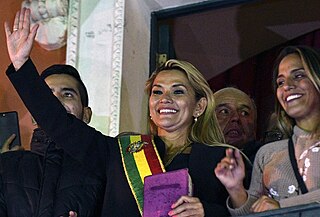
The 2019 Bolivian political crisis was a period of intense political upheaval and unrest in Bolivia that followed the disputed 2019 Bolivian general election, in which incumbent President Evo Morales was initially declared the winner. Morales had run for a controversial fourth term despite having recently lost a constitutional referendum to remove presidential term limits. His bid for reelection was enabled after the Supreme Court then struck down the term limits. The election and the results were heavily contested, with protests occurring across the country as the opposition and many sectors of society alleged that the vote count was manipulated to favor Morales.
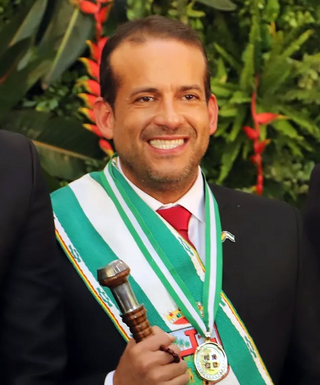
Luis Fernando Camacho Vaca is a Bolivian activist, businessman, lawyer, and politician serving as the 2nd governor of Santa Cruz since 2021. He is the leader of Creemos, opposition bench in the Plurinational Legislative Assembly and was the chair of the Santa Cruz Civic Committee in 2019.

Mónica Eva Copa Murga is a Bolivian politician, social worker, and former student leader serving as mayor of El Alto since 2021. As a member of the Movement for Socialism, she previously served as senator for La Paz from 2015 to 2020, during which time she was president of the Senate from 2019 to 2020.

The 2019–2020 Mexico–Bolivia diplomatic crisis began on 29 October 2019 when the Mexican government congratulated incumbent Bolivian President Evo Morales for his reelection victory. After the election, a preliminary report by the Organization of American States on 9 November reported numerous irregularities in the election, and amid protests and pressure from the Bolivian armed forces and police, Morales was forced to resign.

Fernando Iván Vásquez Arnez is a Bolivian geotechnical and mining engineer and politician who served as minister of mining and metallurgy from 8 May to 30 May 2020. He previously served as vice minister of productive development and metallurgical mining from 2019 to 2020 and as director of the environment and public consultation from 2006 to 2011. Shortly into his ministerial term, Vásquez stated that his white complexion made him incapable of being a member of the Movement for Socialism, causing broad condemnation and his removal from office less than a month after being appointed.

The Arce Cabinet constitutes the 222nd cabinet of the Plurinational State of Bolivia. It was formed on 9 November 2020, one day after Luis Arce was sworn in as the 67th president of Bolivia following the 2020 general election, succeeding the Áñez Cabinet. The cabinet is composed entirely of members of the ruling Movement for Socialism. Described as a "technocratic" cabinet, it has been noted for the low-profile and youth of some of its members as well as its political distance from former president Evo Morales.
Events from the year 2022 in Bolivia.

The 2022 Bolivian ombudsman election took place between 15 March and 23 September 2022 during the term of the 3rd Plurinational Legislative Assembly. This unusual intra-term election for ombudsman of Bolivia was necessitated by the resignation of David Tezanos Pinto on 24 January 2019, leaving Nadia Cruz as the acting authority for more than three years, even exceeding the expiration of Tezanos Pinto's originally set six-year term. This was the sixth ombudsman election since the office was created in 1997. Constitutional lawyer Pedro Callisaya won the contest, receiving ninety-five votes, a two-thirds majority of those present but not of the total membership of both legislative chambers. Callisaya's election was supported only by the ruling Movement for Socialism, while the two opposition blocs boycotted the vote.

Martha Yujra Apaza is a Bolivian politician and trade unionist who served as minister of cultures and tourism from 2019 to 2020. A prominent trade union leader in El Alto, Yujra was the only indigenous member of the Jeanine Áñez Cabinet and was the final official to head the Ministry of Cultures and Tourism; the institution was abolished during her term. During her tenure, Yujra's office primarily dealt with the effects of the COVID-19 pandemic on the cultural sector, devising means of alleviating the economic ramifications of quarantine measures on artisans and entertainers. She subsequently served as a counselor at the Embassy of Bolivia in Quito from July to November 2020. Prior to serving as minister, Yujra gained notoriety for her fierce opposition to the government of Evo Morales. In 2017, she led a breakaway faction of the pro-government El Alto Regional Workers' Center. As its executive secretary, Yujra aligned the union with the Bolivia Says No alliance, running unsuccessfully to represent La Paz in the Chamber of Deputies in the annulled 2019 general elections.

Franz Gróver Choque Ulloa is a Bolivian industrial engineer, lawyer, and politician who served as vice minister of employment, civil service, and cooperatives from 2019 to 2020. A member of the Social Democratic Movement, he previously served as a party-list member of the Chamber of Deputies from Oruro from 2010 to 2014 on behalf of the National Convergence alliance and as a member of the Constituent Assembly from Oruro, representing circumscription 32 from 2006 to 2007 on behalf of the Social Democratic Power alliance.

Pedro Montes Gonzales is a Bolivian mineworker, politician, and trade unionist who served as senator for Oruro from 2015 to 2020. A member of the Movement for Socialism, he previously served as executive secretary of the Bolivian Workers' Center from 2006 to 2012.
